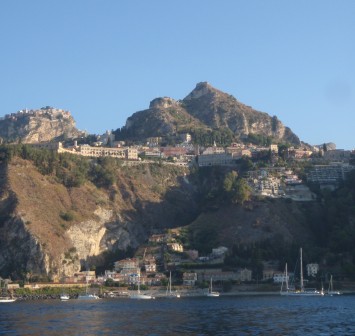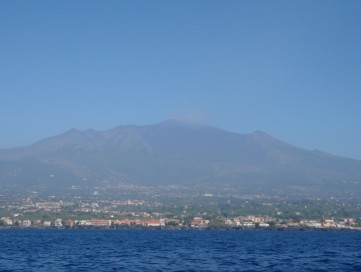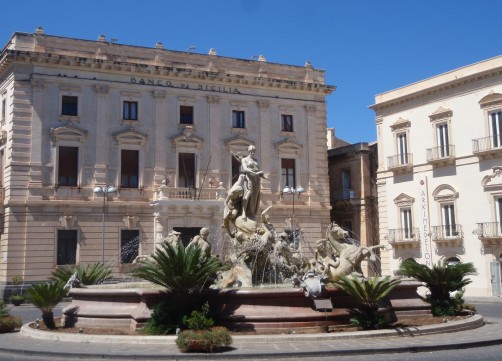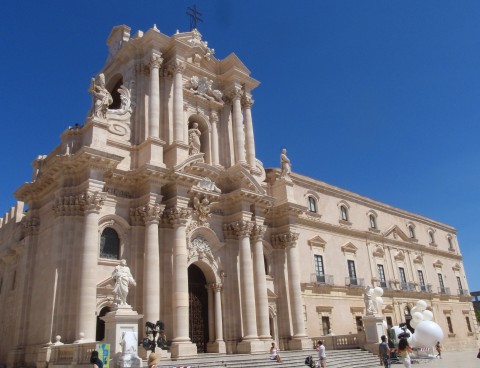SICILY
Sicily has a rich history of waves of invaders that have left their influence. The name of the island of Sicily is derived from a relatively insignificant mainland tribe, the Sicela, that inhabited the island in approximately 1000 BC.
Around 750 BC, the Greeks inhabited eastern Sicily. The Chalcedians inhabited Naxos on the northeast coast and the Corinthians inhabited Siracusa on the southeast coast. The Greeks continued to colonize eastern Sicily, and the Phoenicians inhabited western Sicily. A few hundred years later, the Carthaginians succeeded the Phoenicians in the west, and the stage was set for the inevitable conflict that erupted in 480 BC. The Greeks trounced the Carthaginians. Only a few years later, in 413 BC, Athens challenged the power of Siracusa, and it too was defeated. Siracusa remained a powerful city for two hundred years.
The massive Roman Empire gradually assumed power on the island. The ruler of Siracusa initially joined forces with the Romans, and Siracusa remained a free city-state when Rome occupied Sicily. Later, however, Siracusa sided with the Carthaginians, and the Romans sacked Siracusa. The importance of Sicily declined, and the Romans ruled the island until the empire began to decline.
The island was briefly occupied by the Barbarians and Belisarius for Byzantium, and then the Arabs ruled starting in the 1st century AD. They were followed by the Normans then Spaniards.
Sicily became part of Italy with the Unification in 1870; however, this was not good for Sicily. Sicily and much of southern Italy was essentially ignored by Rome. Sicily gained some autonomy after World War II, and they have since been on a path of slow development.

As we approached Taormina, we could see a mooring field in the northwest corner of the anchorage – the preferred spot. As we headed in that direction, a small launch came out to talk with us. It was George – the person who oversees the moorings. He leases this area (leases the water? from whom we do not know), and he maintains the moorings. He charges 50 Euros per night to tie to his moorings, but we saw ample anchoring space in the bay, so we declined.
Taormina has been inhabited since the 1st century BC, and ruins remain from that time. However, it is now a tourist destination with tourists coming to see nearby Mount Etna. There are numerous churches, restaurants, and a charming train.
Nearby Mount Etna remains a very active volcano. It is the tallest volcano in Europe at 10,922 feet, and it covers 459 square miles. Its fertile surrounding volcanic soil supports extensive agriculture.
Mount Etna has probably been active for a half million years when it was still beneath the sea. It had highly explosive eruptions from 35,000 to 15,000 years ago, and it formed six distinct craters. It continues to have relatively small eruptions.
Smoke started coming from one of the craters on July 4 – just a week before we arrived – leading those in the know to predict that she is going to erupt again in the near future. She continued to belch smoke for the few days we were anchored nearby. But we had our volcano experience in Vanuatu, and we don’t care to be in the neighborhood when she blows.
After resting up a bit and putting the boat back together, we headed south toward Siracusa – a port of entry – on July 13.

50 miles in 9 hours
Siracusa is a historic city and the capital of the Province of Siracusa. The city was founded by Greek Corinthians approximately 2700 years ago – probably 734 or 733 BC.

It is rich with Greek history, culture, amphitheaters, and architecture. It is the birthplace of the mathematician and engineer Archimedes. Cicero described Siracusa as “the greatest Greek city and the most beautiful of them all”. And today it is a UNESCO World Heritage Site.
Ancient Siracusa was on the island of Ortigia, and the city became powerful over time. They were allied with Sparta and Corinth, and there were inevitable clashes with the Carthaginians of western Sicily. Siracusa experienced a slow decline of power, and it was taken over by the Byzantine Empire in 535 AD.
Siracusa experienced devastating earthquakes in 1542 and 1693, but it was rebuilt in Sicilian Baroque architecture. The city was again devastated by plague in 1729 and cholera in 1837. But they again recovered.
Siracusa became part of Italy in 1865 with the Unification, and the walls surrounding the city were demolished in 1870. The bridge connecting it to Sicily was built shortly thereafter.
Siracusa was heavily bombed in World War II during 1943. It is amazing that so much survived.
Siracusa has a large natural harbor with a good anchorage. We spent two nights there as we explored the island and ate pasta. The Sicilians really know how to cook pasta! But we still needed to get to Malta to get our AIS repaired, so we left after only two nights. We headed for Porto Palo which is on the southeast corner of Sicily. The weather dictated otherwise, and we ended up at Lorenzo Vechio.
26 miles in 5 ¼ hours
When we left Siracusa, we intended to go to Porto Palo on the southeast corner of Sicily. However, Porto Palo is exposed to the southeast, and within a few hours, 30 knots of wind was blowing from that direction. So we diverted to LorenzoVecchio – at least we think that is the name of the place.
This was a shallow open roadstead with some protection from the southeast. However, it was still blowing 23 to 28 knots when we anchored, and it blew 30 knots during the evening. The wind shifted to the northeast during the night putting us on a lee shore, but it was light. We waited out the darkness with some anxiety, and we headed to Porto Palo the next morning.

Church in Siracusa
9 miles in 2 hours
Porto Palo is a large fishing harbor open to the south. The entrance and the harbor were both larger than we expected. There is a dock to starboard, but it is three to four deep in trawlers. No chance of a visiting boat tying up there. There is anchoring room straight ahead and to port, but it is shallow. We found a spot we liked and settled in for at least one night.
The weather gurus were reporting gales almost all around us – to the west, north, and east. But there appeared to be a clear corridor south to Malta. We had seen this on the weather charts for a few days, so we were beginning to trust that it might, indeed, exist. We decided that we would give it a try. If the winds and/or seas got ugly, we would return to Porto Palo.
We left at daybreak. Three other sailboats left at the same time and headed in the same direction. We were off to Malta.
When we returned from Malta, we went to Marina di Ragussa. This is a small town on the south coast of Sicily – only about 30 miles west of Porto Palo from where we left to sail to Malta. We were anticipating increased winds, so we went in to the marina planning to stay for two nights. We were there for five.
The marina in Marina di Ragussa is only two years old, and it is quite large. There are not many boats there. The facilities are nice enough, and the people are friendly, but it felt ‘soulless’. It was without any charm of its own.
The winds blew for five days, so we stayed put. We walked around in both the new and old parts of town. We did not care for the new part of town, but the small old town was pleasant. We found a few bakeries and countless ice cream shops (Bud was content).
We had an interesting experience our second night in Marina di Ragussa. There was a large sailing ship in port, and we were given information describing it as the Caravan Stage Ship Theatre Company. They were staging a play on board the ship. Props were hung in the rig, and the performers were on board. The audience was on the dock. The play was called “Uprising!” It was a combination of larger-than-life puppets and aerialists swinging around above the deck. Meanwhile, there was lots of angry dialogue that we could not understand and singing that we could not endure. We lasted 30 minutes and returned to the boat. An odd experience.
We provisioned the boat for up to a week of travel thinking that we might head directly to Gibralter. However, we saw only a three day weather window, so we would go to Sardinia and await another window. We were now just moving from port to port when the winds allowed. We left for Sardinia on July 26.
Sail with us from Italy to Malta or jump ahead to Malta
Come along with us to Sardinia